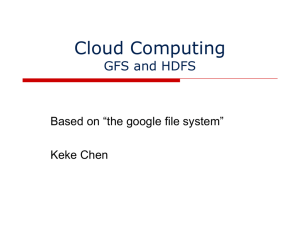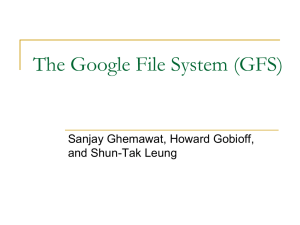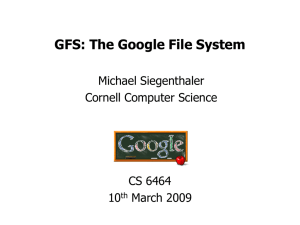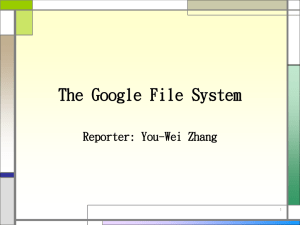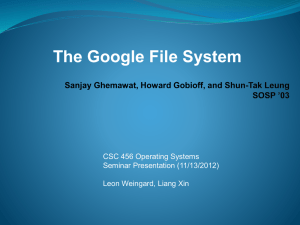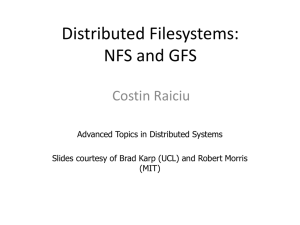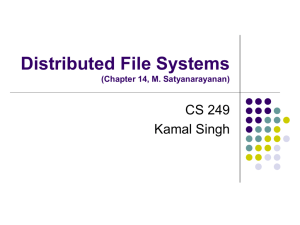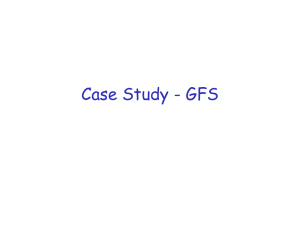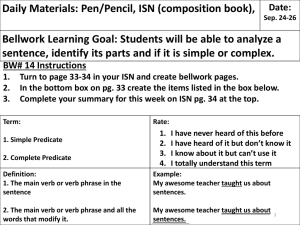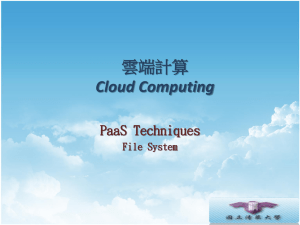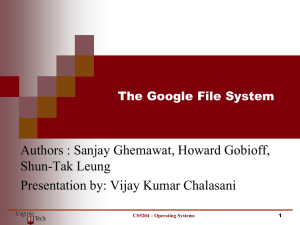slides - CS 491/591: Cloud Computing
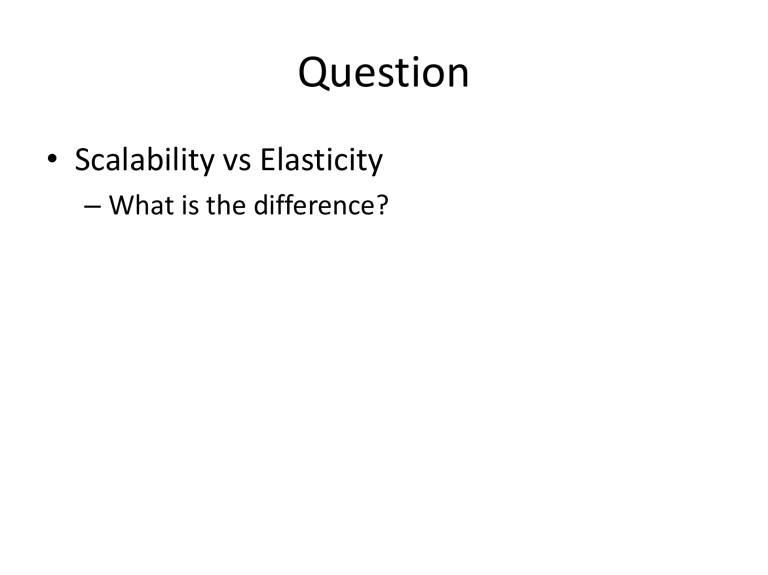
Question
• Scalability vs Elasticity
– What is the difference?
Homework 1
• Installing the open source cloud Eucalyptus in SEC3429
• Individual assignment
• Will need two machines – machine to help with installation and machine on which to install cloud so BRING
YOUR LAPTOP
• Guide to help you – step by step, but you will also need to use Eucalyptus Installation Guide
• When you are done you will have a cloud with a VM instance running on it
• Can use for future work and if not, can say you have installed a cloud and VM image
Components of Eucalyptus
• CLC – cloud controller
• Walrus – Amazon’s S3 for storing VM images
• SC – storage controller
• CC – cluster controllers
• NC – node controllers
Cloud Controller - CLC
• Java program (EC2 compatible interface) and web interface
• Administrative interface for cloud management
• Resource scheduling
• Authentication, accounting, reporting
• Only one CLC per cloud
Walrus
• Written in Java (equivalent to AWS Simple
Storage Service S3)
• Persistent storage to
– all VMs
• VM Images
• Application data
– Volume snapshots (point-in-time copies)
• Can be used as put/get storage as a service
• Only one Walrus per cloud
• Why is it called Walrus – WS3?
Cluster Controller - CC
• Written in C
• Front-end for a cluster within the cloud
• Communicates with Storage Controller and
Node Controller
• Manages VM instance execution and SLAs per cluster
Availability Zones
• Each cluster exists in an availability zone
• A cloud can have multiple locations
• Within each location is a region
• Each region has multiple isolated locations which are called availability zones
• Availability zones are connected through lowlatency links
Storage Controller - SC
• Written in Java (equivalent to AWS Elastic
Block Store EBS)
• Communicates with CC and NC
• Manages Eucalyptus block volumes and snapshots of instances within cluster
• If larger storage needed for application
Node Controller - NC
• Written in C
• Hosts VM instances – where they run
• Manages virtual network endpoints
• Downloads, caches images from Walrus
• Creates and caches instances
• Many NCs per cluster
Interesting Info on Clouds
• What Americans think a compute cloud is
– http://www.citrix.com/lang/English/lp/lp_2328330.asp
Send me interesting links about clouds
Homework
• Read the paper on GFS: Evolution on Fast-
Forward
• Also a link to a longer paper on GFS – original paper from 2003
• I assume you are reading papers as specified in the class schedule
The Original Google File
System
GFS
Some slides from Michael Raines
• During the lecture, you should point out problems with GFS design decisions
Common Goals of GFS and most Distributed File Systems
• Performance
• Reliability
• Scalability
• Availability
GFS Design Considerations
•
• Component failures are the norm rather than the exception.
• File System consists of hundreds or even thousands of storage machines built from inexpensive commodity parts.
• Files are Huge. Multi-GB Files are common.
• Each file typically contains many application objects such as web documents.
• Append, Append, Append.
• Most files are mutated by appending new data rather than overwriting existing data.
•
Co-Designing
Co-designing applications and file system API benefits overall system by increasing flexibility
GFS
• Why assume hardware failure is the norm?
• The amount of layers in a distributed system (network, disk, memory, physical connections, power, OS, application) mean failure on any could contribute to data corruption.
• It is cheaper to assume common failure on poor hardware and account for it, rather than invest in expensive hardware and still experience occasional failure.
Initial Assumptions
• System built from inexpensive commodity components that fail
• Modest number of files – expect few million and 100MB or larger. Didn’t optimize for smaller files
• 2 kinds of reads – large streaming read (1MB), small random reads (batch and sort)
• Well-defined semantics:
– Master/slave, producer/ consumer and many-way merge. 1 producer per machine append to file.
– Atomic RW
• High sustained bandwidth chosen over low latency
(difference?)
High bandwidth versus low latency
• Example:
– An airplane flying across the country filled with backup tapes has very high bandwidth because it gets all data at destination faster than any existing network
– However – each individual piece of data had high latency
Interface
• GFS – familiar file system interface
• Files organized hierarchically in directories, path names
• Create, delete, open, close, read, write
• Snapshot and record append (allows multiple clients to append simultaneously)
– This means atomic read/writes – not transactions!
Master/Servers (Slaves)
• Single master, multiple chunkservers
• Each file divided into fixed-size chunks of 64 MB
– Chunks stored by chunkservers on local disks as Linux files
– Immutable and globally unique 64 bit chunk handle
(name or number) assigned at creation
Master/Servers
– R or W chunk data specified by chunk handle and byte range
– Each chunk replicated on multiple chunkservers – default is 3
Master/Servers
• Master maintains all file system metadata
– Namespace, access control info, mapping from files to chunks, location of chunks
– Controls garbage collection of chunks
– Communicates with each chunkserver through HeartBeat messages
– Clients interact with master for metadata, chunksevers do the rest, e.g. R/W on behalf of applications
– No caching –
• For client working sets too large, simplified coherence
• For chunkserver – chunks already stored as local files, Linux caches MFU in memory
Heartbeats
• What do we gain from Heartbeats?
• Not only do we get the new state of a remote system, this also updates the master regarding failures.
• Any system that fails to respond to a Heartbeat message is assumed dead. This information allows the master to update his metadata accordingly.
• This also queues the Master to create more replicas of the lost data.
Client
• Client translates offset in file into chunk index within file
• Send master request with file name/chunk index
• Master replies with chunk handle and location of replicas
• Client caches info using file name/chunk index as key
• Client sends request to one of the replicas (closest)
• Further reads of same chunk require no interaction
• Can ask for multiple chunks in same request
Master Operations
• Master executes all namespace operations
• Manages chunk replicas
• Makes placement decision
• Creates new chunks (and replicas)
• Coordinates various system-wide activities to keep chunks fully replicated
• Balance load
• Reclaim unused storage
• Do you see any problems?
• Do you question any design decisions?
Master - Justification
• Single Master –
– Simplifies design
– Placement, replication decisions made with global knowledge
– Doesn’t R/W, so not a bottleneck
– Client asks master which chunkservers to contact
Chunk Size - Justification
• 64 MB, larger than typical
• Replica stored as plain Linux file, extended as needed
• Lazy space allocation
• Reduces interaction of client with master
– R/W on same chunk only 1 request to master
– Mostly R/W large sequential files
• Likely to perform many operations on given chunk (keep persistent TCP connection)
• Reduces size of metadata stored on master
Chunk problems
• But –
– If small file – one chunk may be hot spot
– Can fix this with replication, stagger batch application start times
Metadata
• 3 types:
– File and chunk namespaces
– Mapping from files to chunks
– Location of each chunk’s replicas
• All metadata in memory
• First two types stored in logs for persistence
(on master local disk and replicated remotely)
Metadata
• Instead of keeping track of chunk location info
– Poll – which chunkserver has which replica
– Master controls all chunk placement
– Disks may go bad, chunkserver errors, etc.
Metadata - Justification
• In memory –fast
– Periodically scans state
• garbage collect
• Re-replication if chunkserver failure
• Migration to load balance
– Master maintains < 64 B data for each 64 MB chunk
• File namespace < 64B
Chunk size (again)- Justification
• 64 MB is large – think of typical size of email
• Why Large Files?
o METADATA!
• Every file in the system adds to the total overhead metadata that the system must store.
• More individual data means more data about the data is needed.
Operation Log
• Historical record of critical metadata changes
• Provides logical time line of concurrent ops
• Log replicated on remote machines
• Flush record to disk locally and remotely
• Log kept small – checkpoint when > size
• Checkpoint in B-tree form
• New checkpoint built without delaying mutations
(takes about 1 min for 2 M files)
• Only keep latest checkpoint and subsequent logs
Snapshot
• Snapshot makes copy of file
• Used to create checkpoint or branch copies of huge data sets
• First revokes leases on chunks
• Newly created snapshot points to same chunks as source file
• After snapshot, client sends request to master to find lease holder
• Master give lease to new copy
Shadow Master
• Master Replication
– Replicated for reliability
– Not mirrors, so may lag primary slightly
(fractions of second)
– Shadow master read replica of operation log, applies same sequence of changes to data structures as the primary does
Shadow Master
• If Master fails:
– Start shadow instantly
– Read-only access to file systems even when primary master down
– If machine or disk mails, monitor outside GFS starts new master with replicated log
– Clients only use canonical name of master
Creation, Re-replication,
Rebalancing
• Master creates chunk
– Place replicas on chunkservers with below-average disk utilization
– Limit number of recent creates per chunkserver
• New chunks may be hot
– Spread replicas across racks
• Re-replicate
– When number of replicas falls below goal
• Chunkserver unavailable, corrupted, etc.
• Replicate based on priority (fewest replicas)
– Master limits number of active clone ops
Creation, Re-replication,
Rebalancing
• Rebalance
– Periodically moves replicas for better disk space and load balancing
– Gradually fills up new chunkserver
– Removes replicas from chunkservers with belowaverage free space
Leases and Mutation Order
• Chunk lease
• One replica chosen as primary - given lease
• Primary picks serial order for all mutations to chunk
• Lease expires after 60 s
Consistency Model
• Why Append Only?
• Overwriting existing data is not state safe.
o We cannot read data while it is being modified.
• A customized ("Atomized") append is implemented by the system that allows for concurrent read/write, write/write, and read/write/write events.
Consistency Model
Serial success
Concurrent successes
Failure
Write defined
Record Append defined consistent but undefined interspersed with inconsistent inconsistent
Table 1: File Region State After Mutation
Consistency Model
• File namespace mutation (update) atomic
• File Region
• Consistent if all clients see same data
• Region – defined after file data mutation (all clients see writes in entirety, no interference from writes)
• Undefined but Consistent - concurrent successful mutations – all clients see same data, but not reflect what any one mutation has written, fragments of updates
• Inconsistent – if failed mutation (retries)
Consistency
• Relaxed consistency can be accommodated – relying on appends instead of overwrites
• Appending more efficient/resilient to failure than random writes
• Checkpointing allows restart incrementally and no processing of incomplete successfully written data
Namespace Management and
Locking
• Master ops can take time, e.g. revoking leases
– allow multiple ops at same time, use locks over regions for serialization
– GFS does not have per directory data structure listing all files
– Instead lookup table mapping full pathnames to metadata
• Each name in tree has R/W lock
• If accessing: /d1/d2/ ../dn/leaf, R lock on /d1, /d1/d2, etc., W lock on /d1/d2 …/leaf
Locking
• Allows concurrent mutations in same directory
• R lock on directory name prevents directory from being deleted, renamed or snapshotted
• W locks on file names serialize attempts to create file with same name twice
• R/W objects allocated lazily, delete when not in use
• Locks acquired in total order (by level in tree) prevents deadlocks
Fault Tolerance
• Fast Recovery
– Master/chunkservers restore state and start in seconds regardless of how terminated
• Abnormal or normal
• Chunk Replication
Data Integrity
• Checksumming to detect corruption of stored data
• Impractical to compare replicas across chunkservers to detect corruption
• Divergent replicas may be legal
• Chunk divided into 64KB blocks, each with 32 bit checksums
• Checksums stored in memory and persistently with logging
Data Integrity
• Before read, checksum
• If problem, return error to requestor and reports to master
• Requestor reads from replica, master clones chunk from other replica, delete bad replica
• Most reads span multiple blocks, checksum small part of it
• Checksum lookups done without I/O
• Checksum computation optimized for appends
• If partial corrupted, will detect with next read
• During idle, chunkservers scan and verify inactive chunks
Garbage Collection
• Lazy at both file and chunk levels
• When delete file, file renamed to hidden name including delete timestamp
• During regular scan of file namespace
– hidden files removed if existed > 3 days
– Until then can be undeleted
– When removed, in-memory metadata erased
– Orphaned chunks identified and erased
– With HeartBeat message, chunkserver/master exchange info about files, master tells chunkserver about files it can delete, chunkserver free to delete
Garbage Collection
• Easy in GFS
• All chunks in file-to-chunk mappings of master
• All chunk replicas are Linux files under designated directories on each chunkserver
• Everything else garbage
Conclusions
• GFS – qualities essential for large-scale data processing on commodity hardware
• Component failures the norm rather than exception
• Optimize for huge files appended to
• Fault tolerance by constant monitoring, replication, fast/automatic recovery
• High aggregate throughput
– Separate file system control
– Large file size
GFS In the Wild - 2003
• Google currently has multiple GFS clusters deployed for different purposes.
• The largest currently implemented systems have over 1000 storage nodes and over 300 TB of disk storage.
• These clusters are heavily accessed by hundreds of clients on distinct machines.
• Has Google made any adjustments?
• Read paper on New GFS
• Google’s Colossus
OpenStack
• 3 components in the architecture
– Cloud Controller - Nova (compute)
• the cloud computing fabric controller,
• Written in Python, uses external libraries
– Storage Controller –Swift
• Analogous to AWS S3
• Can store billions of objects across nodes
• Built-in redundancy
– Image Controller – Glance
• Manages/stores VM images
• Can use local file system, OpenStack Object Store, S3
